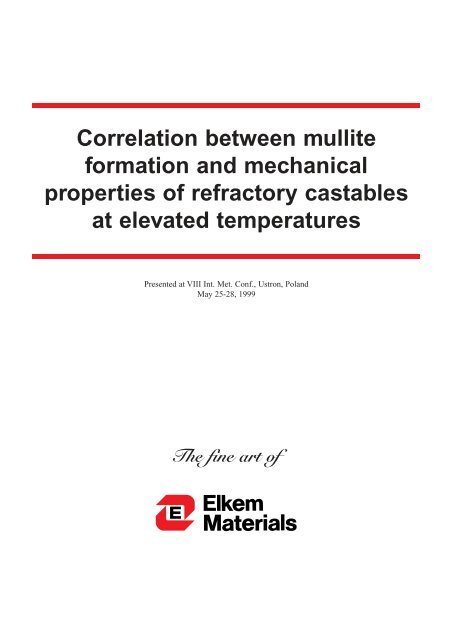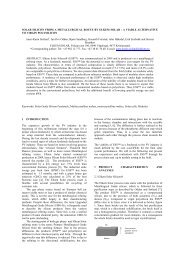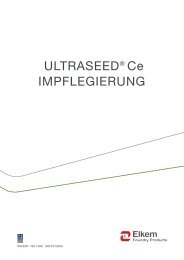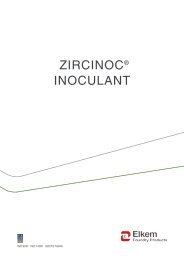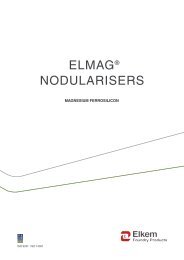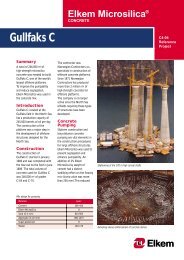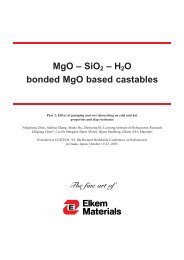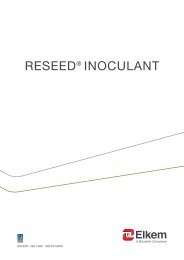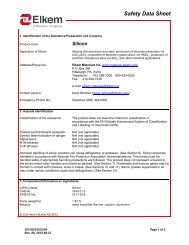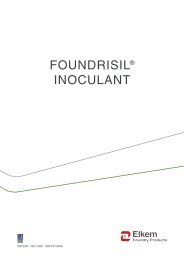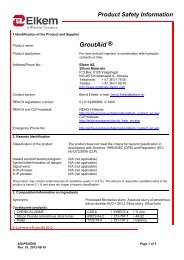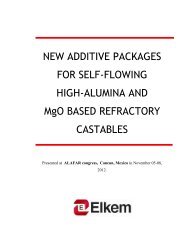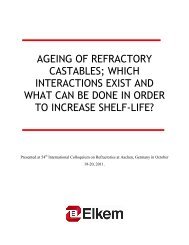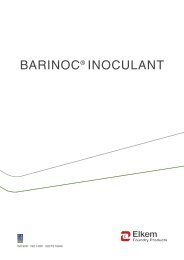Correlation between mullite formation and mechanical ... - Elkem
Correlation between mullite formation and mechanical ... - Elkem
Correlation between mullite formation and mechanical ... - Elkem
Create successful ePaper yourself
Turn your PDF publications into a flip-book with our unique Google optimized e-Paper software.
<strong>Correlation</strong> <strong>between</strong> <strong>mullite</strong><strong>formation</strong> <strong>and</strong> <strong>mechanical</strong>properties of refractory castablesat elevated temperaturesPresented at VIII Int. Met. Conf., Ustron, Pol<strong>and</strong>May 25-28, 1999The fine art of
<strong>Correlation</strong> <strong>between</strong> <strong>mullite</strong> <strong>formation</strong> <strong>and</strong> <strong>mechanical</strong>properties of refractory castables at elevated temperaturesB. Myhre, A.M. Hundere, H. Feldborg <strong>and</strong> C. Ødegård<strong>Elkem</strong> Materials, P.O. Box 8126, Vaagsbygd, N-4675 Kristians<strong>and</strong>, NorwayAbstract:Conditions for <strong>mullite</strong> <strong>formation</strong> are discussed in contextof the special conditions that exist in aluminabased low <strong>and</strong> ultralow cement castables. The <strong>mullite</strong><strong>formation</strong> has been found to depend on several factors,of which the cement content <strong>and</strong> the amount of availablesilica are the most important. Furthermore, thedependence of the hot-strength <strong>and</strong> <strong>mullite</strong> <strong>formation</strong>is demonstrated for the said castables.Introduction:Mullite is frequently seen as a component of the bondphase in refractories. Mullite is known to give highrefractoriness, moderate thermal expansion <strong>and</strong> goodstrength at elevated temperatures resulting in low creeprate <strong>and</strong> good stability. Although it is a very commonmineral phase of fired alumina-silicates, the <strong>formation</strong>of <strong>mullite</strong> is known to be strongly influenced by thecomposition <strong>and</strong> purity of the bond phase. In this presentation,some results will be presented on this topic:published, there still exist some uncertainty regardingwhether <strong>mullite</strong> melts congruently or incongruently.Both incongruent <strong>and</strong> congruent melting have beenfound by various investigations <strong>and</strong> an explanation ofboth was first given by Aksay <strong>and</strong> Pask. 1 Their binarysystem was based on the data of many others in combinationwith their own results. This diagram showsthat under stable conditions <strong>mullite</strong> melts incongruently.According to Risbud <strong>and</strong> Pask, 2 congruent meltingof <strong>mullite</strong> is experienced under metastable conditions.Figure 1 shows a revised version of the phase diagrampresented by Risbud <strong>and</strong> Pask. 3For users of refractory castables, the melting behaviorof pure <strong>mullite</strong> is normally of secondary interest.Softening of <strong>mullite</strong> containing castables is usuallycaused by ternary impurities, like CaO in cement bondedhigh-alumina systems. In castables with microsilica<strong>and</strong> alumina where strengthening is supposed tooccur by <strong>mullite</strong> <strong>formation</strong>, another aspect of the phasediagram is much more critical than the melting behavior;namely the <strong>formation</strong> of the <strong>mullite</strong>.Background:Few mineral phases have the same significance inrefractories as <strong>mullite</strong>. The mineral, named after theScottish Isle of Mull, is rarely found in nature, but is acommon mineral in fired alumina-silicate materials.Mullite is the only stable high-temperature phase <strong>between</strong>alumina <strong>and</strong> silica <strong>and</strong> the composition is commonlyexpressed as A 3 S 2 where A=Al 2 O 3 <strong>and</strong> S=SiO 2 .However, it is today widely accepted that <strong>mullite</strong> hasno fixed composition but exhibits a solid solutionrange. There is some dispute about the solid solutionrange, but from around 71 wt% to 74 wt% aluminaseems to be within most proposals. The largest disputehowever has been about the thermochemical nature ofthe <strong>mullite</strong>, i.e. the melting behavior. Although a largenumber of investigations concerning this has beenFigure 1: The phase diagram Al 2 O 3 -SiO 2 (Risbud <strong>and</strong> Pask 1978)2
The phase diagram of Figure 1 was made by carefulstudies of contact areas <strong>between</strong> alumina <strong>and</strong> silica,<strong>and</strong> revealed that upon heating, a liquid forms in thecontact area before <strong>mullite</strong> precipitates. This metastablesystem is indicated as a dotted line in the extensionof the liquidus curve in the phase diagram (Fig. 1).Thus a metastable, simple eutectic system with a calculatedeutectic at approximately 12 mole% alumina<strong>and</strong> 1260°C was found.High-alumina castables containing microsilica <strong>and</strong> finealumina in the bond phase, generally softens at temperaturesabove 1200-1300°C. Depending on the cement(impurity) content <strong>and</strong> the amount of microsilica present,this softening may be of temporary nature. Afterprolonged heating, an increase in hot-M.O.R. may befound at temperatures above 1200-1300°C. The temperaturesat which the softening commences seem to bedepending on the impurity level, primarily in the superfinesbut also in the bulk. Earlier, the softening hasbeen attributed low melting phases in the system alumina-silica-calcia,but with the evolution of essentiallycement free castables it was realized that the softeningwas still present even without calcia from the cement.Even though this does not rule out the calcium containingliquid, also other explanations had to be found. Asthe eutectic temperature of the metastable system inthe alumina-silica system coincides with the observedsoftening temperatures, it therefore seems likely thatthe origin of the softening in the cement free <strong>and</strong> ultralowcement systems is the metastable system found inthe alumina-silica system depicted in Figure 1.Absence of <strong>mullite</strong> <strong>formation</strong> normally has one maincause; lack of available silica or too much calcia orother fluxing oxides. This is really two sides of thesame issue since a certain amount of the silica goesinto solution together with the fluxing oxides, sometimesgiving other silica containing phases like anorthite.When a potentially <strong>mullite</strong> forming castable is heatedfor the first time, it has been found that the microsilica<strong>and</strong> the cement reacts almost quantitatively <strong>and</strong> yieldsa liquid at temperatures around 1200-1300°C. It isfrom this liquid that <strong>mullite</strong> grows. Since all microsilica<strong>and</strong> all cement reacts to a liquid 4 , the amount of viscousliquid may reach substantial amounts - around10% of the castable is not uncommon, <strong>and</strong> the strengthof such a castable gets low. With <strong>mullite</strong> <strong>formation</strong> thislow strength is however of temporary nature as the<strong>mullite</strong> precipitation both reinforces <strong>and</strong> reduces theamount substantially. This is seen as a strengtheningwith time.Where almost no cement is used, the same mechanismsseem to apply, this time the liquid is supplied by themetastable system referred to above.When <strong>mullite</strong> <strong>formation</strong> has ceased, in the presence ofcalcia, a certain amount of silica remains in a residualliquid that has been found 4 to correspond approximatelyto the composition of the ternary peritectic at1512°C located close to the composition of anorthite,see Figure 2. This means that since the <strong>mullite</strong> growsout of this liquid, the liquid is infiltrated with <strong>mullite</strong>crystals. Mullite crystals within a liquid probably doesnot add much to strength unless they bridge two neighboringaggregate particles. Thanks to the normallyneedle-like habit of the <strong>mullite</strong> crystals this happensrelatively easily though. During the <strong>mullite</strong> precipitation,the amount of liquid also has been reduced sothat for some castable compositions, only traces areleft. With time also the last traces of liquid may solidify<strong>and</strong> crystallize. The liquid seems to be quite “persistent”though so the last mentioned step may takeexcessively long time. Out of the microsilica that isadded to the castable, a certain fraction maintain inthese liquid residues <strong>and</strong> does not add much tostrength. Since they are infiltrated with <strong>mullite</strong> crystals,neither this <strong>mullite</strong> is expected to add significantlyto strength unless they bridge adjacent particles. So,all in all, it is the microsilica that is in excess of whatgoes into the liquid <strong>and</strong> as non-bridging that adds tostrength.Experimental results <strong>and</strong> discussionTo investigate the effect of <strong>mullite</strong> <strong>formation</strong> further,castables based on white fused alumina (UniversalAbrasives) <strong>and</strong> calcined alumina (ALCOA) with varyingamounts of microsilica (<strong>Elkem</strong> Materials) <strong>and</strong>cement in the bond phase were prepared. All castableshad similar particle size distribution <strong>and</strong> equal amountof water for casting. The particle size distribution followedthe Andreassen distribution with top size 4 mm<strong>and</strong> q-value approximately 0.25. 13 volume % waterwas added for casting. In terms of weight 13 vol%equals to 3.8-4.2 wt% depending on microsilica content.The castable were prepared in such a way that theycontained 2, 4, 6 or 8wt% microsilica. Table 1 showsthe composition of the bond-phase of the castables ifthe bond phase is defined as the components with asize below approximately 45 µm.3
Table 1: Chemical composition of the bond-phase (fractions < 45 micron).Table 2: Samples, time <strong>and</strong> <strong>mullite</strong> content after firing at 1400°C.Figure 2: The phase diagram Al 2 O 3 -SiO 2 -CaO after Osborn <strong>and</strong> Muan. 5Approximate compositions of the bond phases are indicated byx(LCC) or o(ULCC). The peritectic at 1512°C <strong>and</strong> the join fromCaO/(CaO+SiO 2 )=0.22 towards the alumina corner is also indicated.In Figure 2 the phase diagram Al 2 O 3 -SiO 2 -CaO isshown with the approximate composition of the bondphases indicated by an x(LCC) or a circle(ULCC).From the compositions in the phase diagram, we seethat all ultralow-cement compositions have a theoreticallymay yield <strong>mullite</strong>, since all are located withinalkemade triangles where <strong>mullite</strong> is a coexisting phase.For the low cement compositions, the castable with2wt% microsilica has a composition that is not coexistingwith <strong>mullite</strong> - hence no, or only small amounts of<strong>mullite</strong> will be expected. Also the one with 4wt%microsilica(LCC) has a composition that should giveonly small amounts of <strong>mullite</strong>.For the sample preparation, prismatic samples wereprepared of the various castables, fired at 1400°C forvarious duration’s, before quantitative XRD analyseswith respect to <strong>mullite</strong> was performed.Table 2 summarizes the samples, conditions <strong>and</strong><strong>mullite</strong> content that was detected.The sample with 2 wt% microsilica <strong>and</strong> 6wt% cementwas omitted in the XRD analyses. We see that for afixed composition, the <strong>mullite</strong> content is a function ofthe time at temperature (here 1400°C), the microsilicacontent <strong>and</strong> the cement content. Generally, high microsilica<strong>and</strong> low cement content together with long timeat sufficiently high temperature favours <strong>formation</strong> of<strong>mullite</strong>. The somewhat quicker <strong>mullite</strong> <strong>formation</strong> in thesample with 6wt% microsilica should be attributed tothe presence of reactive alumina in the samples withless than 8wt% microsilica. The presence of reactivealumina in castables with less than 8wt% microsilicawas in order to maintain a constant particle size distributionalso when microsilica is removed from thesystem.Like it has been demonstrated earlier, there seems to bea need for a minimum amount of microsilica to get<strong>mullite</strong> <strong>formation</strong>. This is dependent on the amount ofcement present which is in line with earlier findings. Ifthe low cement castable with 8 <strong>and</strong> 6 wt% microsilicais considered, one may do simple calculations* of thecomposition of the remaining glassy phase after 24h.This coincides excellently with the peritectic at1512°C that is indicated in the phase diagram. Theliquid thus contains somewhat less than 6 out of theoriginal 8 (or 6)wt% microsilica, <strong>and</strong> is another exampleof <strong>mullite</strong> <strong>formation</strong> being hindered by the cementof low cement castables.* The calculations are performed by calculating the CaO/(CaO+SiO 2 ) from the cement content <strong>and</strong> the original microsilica content compensating for the silicain the <strong>mullite</strong> (24h). Here this fraction equals to 0.22 for both 8 <strong>and</strong> 6wt% microsilica. If 22% CaO is indicated on the join <strong>between</strong> CaO <strong>and</strong> SiO 2 in thephase diagram <strong>and</strong> a join towards the Al 2 O 3 corner is drawn, then this join passes very close to the peritectic at 1512°C. See Figure 2.4
For the ultralow cement castables a similar analysesmay be made, but here one finds that <strong>between</strong> 2 <strong>and</strong>4wt% of the initial microsilica remains in the residualliquid. Hence, to get <strong>mullite</strong> <strong>formation</strong> at all, <strong>between</strong>2 <strong>and</strong> 4wt% microsilica has to be added even to theseultralow cement castables. This result correlates wellwith earlier findings 4 where the liquid has been directlyanalyzed using SEM/EDAX.Hot strength:If one starts to measure hot-M.O.R. of such <strong>mullite</strong> formingalumina-silica castables, a characteristic patternwill appear around 1300°C. Figure 3 shows an exampleof such hot-M.O.R. measurements, showing thecharacteristic “dip” that may be seen around 1300°C.At 1300°C the castables are soft giving a plastic fracture,even after 24hours at temperature. Both at 1400<strong>and</strong> 1200°C however, fracture is brittle. If strength ismonitored as a function of time however, at 1400°C thestrengths immediately after heat-up are relatively low,with soft fracture. With time, strength increases <strong>and</strong> thefracture gets brittle. This behavior is attributed to <strong>mullite</strong>growing out of a liquid, with simultaneous reductionin the amount of liquid. As these processes are verytemperature dependent, involving material transport bydiffusion etc., at 1300°C the softness remains evenafter 24 hours. The softening has traditionally beenattributed to liquid <strong>formation</strong> caused by the cement, butas one found that the same thing happens with 0.5wt%cement, one started wondering whether other factorscould contribute. A test sample was then made entirelywithout cement. And gave the same pattern. Thus theexplanation had to be found elsewhere than in thecement alone.effects we see in Figure 3 with softening i.e. liquid <strong>formation</strong><strong>between</strong> 1200 <strong>and</strong> 1300°C even for the cementfree system. Furthermore as the strengths are reasonablyhigh at 1300°C this implies that the liquid is veryviscous - all in line with the expectations from thephase diagram.This does not exclude that the lime from the cementplays an important role in the <strong>mullite</strong> <strong>formation</strong>, it justpoints out that even without cement, a softening is tobe expected in systems consisting of alumina <strong>and</strong>(micro)silica. If cement is present, the cement is a partof the liquid <strong>and</strong> gives a liquid with somewhat lowerviscosity. The latter effect may speed up the <strong>mullite</strong><strong>formation</strong> as is seen in Table 2. A certain amount of<strong>mullite</strong> has probably been precipitated in the LCC ofFigure 3 at 1300°C which explains why the LCC hashigher strength than the other. At higher temperatures,i.e. 1500°C, impurities like CaO will radically lowerthe hot-strength, cp. Fig 3.ULCCFigure 4 shows the hot-M.O.R. of the ultralow-cementcastables after 24 hours at temperature, <strong>and</strong> shows withone exception, 2wt% microsilica, the familiar patternof softening around 1300°C followed by strengtheningaround 1400°C. According to the previous discussion,it is unlikely that these castables loose strength at1300°C by <strong>formation</strong> of low-melting CaO containingliquids alone. Here the main contributor to the softeningprobably is in the meta-stable liquid <strong>formation</strong> inthe alumina-silica system. The castable with 2wt%microsilica does not increase in strength because theamount of available silica (2wt%) does not exceed theminimum amount that has been indicated earlier (<strong>between</strong>2 <strong>and</strong> 4wt%). If there is not sufficient silica available,<strong>mullite</strong> <strong>formation</strong> will be inadequate or absent.Mullite <strong>formation</strong> is proportional to the silica content<strong>and</strong> the hot-strength at 1500°C reflects the amount of<strong>mullite</strong> that forms.Figure 3: Hot M.O.R. of fused alumina based castables with 8 wt% microsilicaas a function of temperature. q=0.25, max. particle size4mm, 13 vol% water for casting (4.2wt%).Reverting to Figure 1, the phase diagram Al 2 O 3 -SiO 2 ,this tells us that even in very pure systems, the <strong>mullite</strong><strong>formation</strong> goes through some viscous liquid high insilica, <strong>and</strong> that this metastable system has an indicatedeutectic around 1260°C. This coincides well with theFigure 4: Hot-M.O.R. of ultralow cement (0.5wt% cement), fused aluminabased castables as a function of temperature. Castables with differentamounts of microsilica. 24hours at temperature. q=0.25,max. particle size 4mm, 13 vol% water for casting (3.8-4.2wt%).5
The world-wide distributionnetwork<strong>Elkem</strong> Refractories markets <strong>Elkem</strong> Microsilica®world-wide either directly, through <strong>Elkem</strong>’s salesoffices or through local agents.Research on refractory applications is carried out at themain research center in Norway. Our technical staff istrained to assist producers <strong>and</strong> users with refractorytechnology.<strong>Elkem</strong> is the world’s largest producer of high qualitymicrosilica for refractories. For our customers, thismeans reliable supplies. <strong>Elkem</strong> Microsilica is producedat various locations in North America <strong>and</strong> Europe, <strong>and</strong>is delivered in a variety of packaging.<strong>Elkem</strong> Microsilica provides users, producers <strong>and</strong>installation teams with refractories that gives improvedeconomy. <strong>Elkem</strong> Refractories st<strong>and</strong>s ready to supply<strong>Elkem</strong> Microsilica <strong>and</strong> related technology for yourcurrent <strong>and</strong> future needs.<strong>Elkem</strong> Microsilica® is registered trademark owned by <strong>Elkem</strong>.France:<strong>Elkem</strong>, 52 avenue de la Gr<strong>and</strong>e-Armèe, F-75017 ParisTel.: +33 1 45 74 03 54, Fax: +33 1 45 74 03 80Germany: <strong>Elkem</strong>, Schirmerstrasse 76, Postfach 102220D-400013 Düsseldorf 1Tel.: +49 211 368110, Fax: +49 211 360523Great Britain: <strong>Elkem</strong> Alloys, 301 Glossop Road, Sheffield S 10 2HLTel.: +44 1142 70 03 34, Fax: +44 1142 75 31 03China:India:<strong>Elkem</strong> International Trade Co. Ltd. (Shanghai)Room 2507, Jin Mao Building No 177Lu Jia Zui Rd. Shanghai 200120Tel.: +86 21 5047 6600, Fax: +86 21 5047 0899<strong>Elkem</strong> Metallurgy, 66/67 Mahavir CentreSector no. 17, Plot no. 77, Vashi, New Bombay 400703Tel.: +91 22 789 6407, Fax: +91 22 789 6410Italy:<strong>Elkem</strong>, Centro Direzionale Volleoni, Palazzo Taurus (A3),Viale Colleoni, 5. I-20041 Agrate Brinza (Mi)Tel.: +39 39 6057021, Fax: +39 39 6057019Japan: <strong>Elkem</strong> Japan, Nikko Sanno Bldg. #4015-3, Akasaka 2-chome, Minato-ku, Tokyo 107Tel.: +81 3 3584 7712, Fax: +81 3 3584 0437Norway:<strong>Elkem</strong> Materials, P.O.Box 8126 VaagsbygdN-4675 Kristians<strong>and</strong>Tel.: +47 38 01 75 00, Fax: +37 38 01 49 70USA: <strong>Elkem</strong> Materials Inc., P.O.Box 266Pittsburgh, PA 15230Tel.: +1 412 299 7900, Fax: +1 412 299 7238TVEDT TRYKKERI AS – KRISTIANSAND


